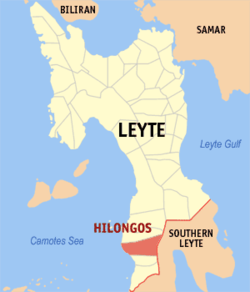Hilongos
| Hilongos | ||
|---|---|---|
| Municipality | ||

Immaculate Conception Parish Church
|
||
|
||
 Map of Leyte with Hilongos highlighted |
||
| Location within the Philippines | ||
| Coordinates: 10°22′N 124°45′E / 10.37°N 124.75°ECoordinates: 10°22′N 124°45′E / 10.37°N 124.75°E | ||
| Country | Philippines | |
| Region | Eastern Visayas (Region VIII) | |
| Province | Leyte | |
| District | 5th district of Leyte | |
| Established | 1737 | |
| Barangay | 51 (see Barangays) | |
| Government | ||
| • Mayor | Albert Villahermosa (LP) | |
| • Vice mayor | Manuel Gabisan | |
| Area | ||
| • Total | 192.92 km2 (74.49 sq mi) | |
| Population (2015 census) | ||
| • Total | 63,431 | |
| • Density | 330/km2 (850/sq mi) | |
| Time zone | PST (UTC+8) | |
| ZIP code | 6524 | |
| IDD : area code | +63 (0)53 | |
| Income class | 2nd municipal income class | |
| 083719000 | ||
| Electorate | 38,076 voters (2016) | |
Hilongos is a 2nd class municipality in the province of Leyte, Philippines. According to the 2015 census, it has a population of 63,431 people.
Hilongos shares its border with the Municipality of Hindang in the north, the Municipalities of Sogod (Southern Leyte) and (Southern Leyte) in the east, the Municipality of Bato in the south and the Camotes Sea in the west. Hilongos is the biggest municipality in terms of income, population and land area in the south-western part of Leyte, a string of five (5) equidistant and thriving municipalities namely, Inopacan, Hindang, Hilongos, Bato and Matalom comprises the south-western part of Leyte. Hilongos is the center of shipping, commerce, rice production, government and ecclesiastical offices, health facilities, education, sports and socio-cultural activities and telecommunications in the south-western part of Leyte. The Port of Hilongos is one of the biggest and busiest in Leyte. Also, Hilongos is equipped with an airport, which can be more helpful and useful if improved. At present, Hilongos has two (2) public markets, the old one and the new one respectively. The Municipality of Hilongos is composed of fifty-one (51) strong barangays with vast coastal plains used mainly in the production of rice.
Hilongos comprises 51 barangays:
Lore has it that in the 12th century, Amahawin, an Ilonggo from Iloilo, conquered neighboring barangays on Leyte’s western shore and extended his territory to the present limits of Inopacan, Hindang, Bato, and Matalom. He formed a settlement and named it Hilongos, because its inhabitants were Ilonggos.
...
Wikipedia


